Refine search
No keyword found to refine search
keywords EN
Places
Names
55 documents found
| 1 |
Documents per page :
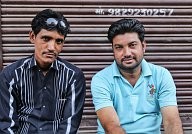
Rajasthan
Sandrine Huet / Le Pictorium
LePictorium_0146577.jpg
Pictures of Rajasthan, portraits and lifestyles
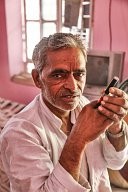
Portraits of men in Rajasthan
Sandrine Huet / Le Pictorium
LePictorium_0146582.jpg
Men of Rajasthan are very often breeders, ex nomads called Raikas.
they wear a 9 meter-long turban that is the main piece of their traditional costume. It has multi purposes and informs on the man's social status. Men in Rajasthan often have a mustache as a symbol of their virility.
they wear a 9 meter-long turban that is the main piece of their traditional costume. It has multi purposes and informs on the man's social status. Men in Rajasthan often have a mustache as a symbol of their virility.
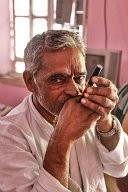
Portraits of men in Rajasthan
Sandrine Huet / Le Pictorium
LePictorium_0146583.jpg
Men of Rajasthan are very often breeders, ex nomads called Raikas.
they wear a 9 meter-long turban that is the main piece of their traditional costume. It has multi purposes and informs on the man's social status. Men in Rajasthan often have a mustache as a symbol of their virility.
they wear a 9 meter-long turban that is the main piece of their traditional costume. It has multi purposes and informs on the man's social status. Men in Rajasthan often have a mustache as a symbol of their virility.

Portraits of men in Rajasthan
Sandrine Huet / Le Pictorium
LePictorium_0146584.jpg
Men of Rajasthan are very often breeders, ex nomads called Raikas.
they wear a 9 meter-long turban that is the main piece of their traditional costume. It has multi purposes and informs on the man's social status. Men in Rajasthan often have a mustache as a symbol of their virility.
they wear a 9 meter-long turban that is the main piece of their traditional costume. It has multi purposes and informs on the man's social status. Men in Rajasthan often have a mustache as a symbol of their virility.
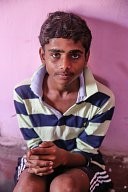
Portraits of men in Rajasthan
Sandrine Huet / Le Pictorium
LePictorium_0146585.jpg
Men of Rajasthan are very often breeders, ex nomads called Raikas.
they wear a 9 meter-long turban that is the main piece of their traditional costume. It has multi purposes and informs on the man's social status. Men in Rajasthan often have a mustache as a symbol of their virility.
they wear a 9 meter-long turban that is the main piece of their traditional costume. It has multi purposes and informs on the man's social status. Men in Rajasthan often have a mustache as a symbol of their virility.
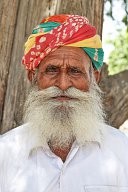
Portraits of men in Rajasthan
Sandrine Huet / Le Pictorium
LePictorium_0146588.jpg
Men of Rajasthan are very often breeders, ex nomads called Raikas.
they wear a 9 meter-long turban that is the main piece of their traditional costume. It has multi purposes and informs on the man's social status. Men in Rajasthan often have a mustache as a symbol of their virility.
they wear a 9 meter-long turban that is the main piece of their traditional costume. It has multi purposes and informs on the man's social status. Men in Rajasthan often have a mustache as a symbol of their virility.
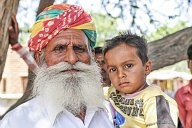
Portraits of men in Rajasthan
Sandrine Huet / Le Pictorium
LePictorium_0146589.jpg
Men of Rajasthan are very often breeders, ex nomads called Raikas.
they wear a 9 meter-long turban that is the main piece of their traditional costume. It has multi purposes and informs on the man's social status. Men in Rajasthan often have a mustache as a symbol of their virility.
they wear a 9 meter-long turban that is the main piece of their traditional costume. It has multi purposes and informs on the man's social status. Men in Rajasthan often have a mustache as a symbol of their virility.
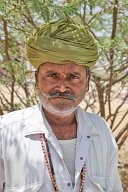
Portraits of men in Rajasthan
Sandrine Huet / Le Pictorium
LePictorium_0146590.jpg
Men of Rajasthan are very often breeders, ex nomads called Raikas.
they wear a 9 meter-long turban that is the main piece of their traditional costume. It has multi purposes and informs on the man's social status. Men in Rajasthan often have a mustache as a symbol of their virility.
they wear a 9 meter-long turban that is the main piece of their traditional costume. It has multi purposes and informs on the man's social status. Men in Rajasthan often have a mustache as a symbol of their virility.
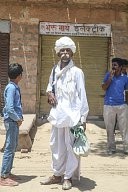
Portraits of men in Rajasthan
Sandrine Huet / Le Pictorium
LePictorium_0146591.jpg
Men of Rajasthan are very often breeders, ex nomads called Raikas.
they wear a 9 meter-long turban that is the main piece of their traditional costume. It has multi purposes and informs on the man's social status. Men in Rajasthan often have a mustache as a symbol of their virility.
they wear a 9 meter-long turban that is the main piece of their traditional costume. It has multi purposes and informs on the man's social status. Men in Rajasthan often have a mustache as a symbol of their virility.
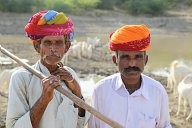
Portraits of men in Rajasthan
Sandrine Huet / Le Pictorium
LePictorium_0146592.jpg
Men of Rajasthan are very often breeders, ex nomads called Raikas.
they wear a 9 meter-long turban that is the main piece of their traditional costume. It has multi purposes and informs on the man's social status. Men in Rajasthan often have a mustache as a symbol of their virility.
they wear a 9 meter-long turban that is the main piece of their traditional costume. It has multi purposes and informs on the man's social status. Men in Rajasthan often have a mustache as a symbol of their virility.
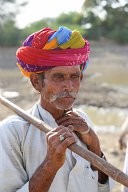
Portraits of men in Rajasthan
Sandrine Huet / Le Pictorium
LePictorium_0146593.jpg
Men of Rajasthan are very often breeders, ex nomads called Raikas.
they wear a 9 meter-long turban that is the main piece of their traditional costume. It has multi purposes and informs on the man's social status. Men in Rajasthan often have a mustache as a symbol of their virility.
they wear a 9 meter-long turban that is the main piece of their traditional costume. It has multi purposes and informs on the man's social status. Men in Rajasthan often have a mustache as a symbol of their virility.
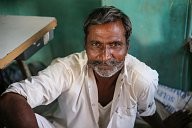
Portraits of men in Rajasthan
Sandrine Huet / Le Pictorium
LePictorium_0146594.jpg
Men of Rajasthan are very often breeders, ex nomads called Raikas.
they wear a 9 meter-long turban that is the main piece of their traditional costume. It has multi purposes and informs on the man's social status. Men in Rajasthan often have a mustache as a symbol of their virility.
they wear a 9 meter-long turban that is the main piece of their traditional costume. It has multi purposes and informs on the man's social status. Men in Rajasthan often have a mustache as a symbol of their virility.
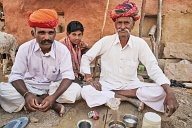
Portraits of men in Rajasthan
Sandrine Huet / Le Pictorium
LePictorium_0146595.jpg
Men of Rajasthan are very often breeders, ex nomads called Raikas.
they wear a 9 meter-long turban that is the main piece of their traditional costume. It has multi purposes and informs on the man's social status. Men in Rajasthan often have a mustache as a symbol of their virility.
they wear a 9 meter-long turban that is the main piece of their traditional costume. It has multi purposes and informs on the man's social status. Men in Rajasthan often have a mustache as a symbol of their virility.
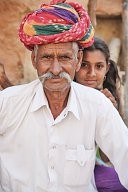
Portraits of men in Rajasthan
Sandrine Huet / Le Pictorium
LePictorium_0146596.jpg
Men of Rajasthan are very often breeders, ex nomads called Raikas.
they wear a 9 meter-long turban that is the main piece of their traditional costume. It has multi purposes and informs on the man's social status. Men in Rajasthan often have a mustache as a symbol of their virility.
they wear a 9 meter-long turban that is the main piece of their traditional costume. It has multi purposes and informs on the man's social status. Men in Rajasthan often have a mustache as a symbol of their virility.
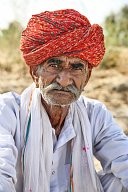
Portraits of men in Rajasthan
Sandrine Huet / Le Pictorium
LePictorium_0146609.jpg
Men of Rajasthan are very often breeders, ex nomads called Raikas.
they wear a 9 meter-long turban that is the main piece of their traditional costume. It has multi purposes and informs on the man's social status. Men in Rajasthan often have a mustache as a symbol of their virility.
they wear a 9 meter-long turban that is the main piece of their traditional costume. It has multi purposes and informs on the man's social status. Men in Rajasthan often have a mustache as a symbol of their virility.
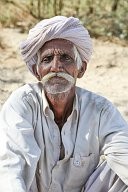
Portraits of men in Rajasthan
Sandrine Huet / Le Pictorium
LePictorium_0146610.jpg
Men of Rajasthan are very often breeders, ex nomads called Raikas.
they wear a 9 meter-long turban that is the main piece of their traditional costume. It has multi purposes and informs on the man's social status. Men in Rajasthan often have a mustache as a symbol of their virility.
they wear a 9 meter-long turban that is the main piece of their traditional costume. It has multi purposes and informs on the man's social status. Men in Rajasthan often have a mustache as a symbol of their virility.
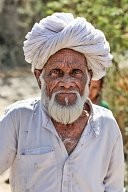
Portraits of men in Rajasthan
Sandrine Huet / Le Pictorium
LePictorium_0146611.jpg
Men of Rajasthan are very often breeders, ex nomads called Raikas.
they wear a 9 meter-long turban that is the main piece of their traditional costume. It has multi purposes and informs on the man's social status. Men in Rajasthan often have a mustache as a symbol of their virility.
they wear a 9 meter-long turban that is the main piece of their traditional costume. It has multi purposes and informs on the man's social status. Men in Rajasthan often have a mustache as a symbol of their virility.
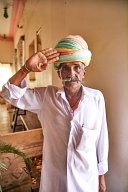
Portraits of men in Rajasthan
Sandrine Huet / Le Pictorium
LePictorium_0146618.jpg
Men of Rajasthan are very often breeders, ex nomads called Raikas.
they wear a 9 meter-long turban that is the main piece of their traditional costume. It has multi purposes and informs on the man's social status. Men in Rajasthan often have a mustache as a symbol of their virility.
they wear a 9 meter-long turban that is the main piece of their traditional costume. It has multi purposes and informs on the man's social status. Men in Rajasthan often have a mustache as a symbol of their virility.
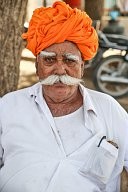
Portraits of men in Rajasthan
Sandrine Huet / Le Pictorium
LePictorium_0146619.jpg
Men of Rajasthan are very often breeders, ex nomads called Raikas.
they wear a 9 meter-long turban that is the main piece of their traditional costume. It has multi purposes and informs on the man's social status. Men in Rajasthan often have a mustache as a symbol of their virility.
they wear a 9 meter-long turban that is the main piece of their traditional costume. It has multi purposes and informs on the man's social status. Men in Rajasthan often have a mustache as a symbol of their virility.
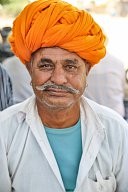
Portraits of men in Rajasthan
Sandrine Huet / Le Pictorium
LePictorium_0146620.jpg
Men of Rajasthan are very often breeders, ex nomads called Raikas.
they wear a 9 meter-long turban that is the main piece of their traditional costume. It has multi purposes and informs on the man's social status. Men in Rajasthan often have a mustache as a symbol of their virility.
they wear a 9 meter-long turban that is the main piece of their traditional costume. It has multi purposes and informs on the man's social status. Men in Rajasthan often have a mustache as a symbol of their virility.
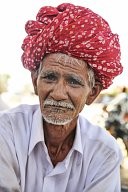
Portraits of men in Rajasthan
Sandrine Huet / Le Pictorium
LePictorium_0146621.jpg
Men of Rajasthan are very often breeders, ex nomads called Raikas.
they wear a 9 meter-long turban that is the main piece of their traditional costume. It has multi purposes and informs on the man's social status. Men in Rajasthan often have a mustache as a symbol of their virility.
they wear a 9 meter-long turban that is the main piece of their traditional costume. It has multi purposes and informs on the man's social status. Men in Rajasthan often have a mustache as a symbol of their virility.
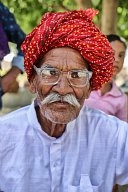
Portraits of men in Rajasthan
Sandrine Huet / Le Pictorium
LePictorium_0146622.jpg
Men of Rajasthan are very often breeders, ex nomads called Raikas.
they wear a 9 meter-long turban that is the main piece of their traditional costume. It has multi purposes and informs on the man's social status. Men in Rajasthan often have a mustache as a symbol of their virility.
they wear a 9 meter-long turban that is the main piece of their traditional costume. It has multi purposes and informs on the man's social status. Men in Rajasthan often have a mustache as a symbol of their virility.
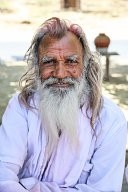
Portraits of men in Rajasthan
Sandrine Huet / Le Pictorium
LePictorium_0146624.jpg
Men of Rajasthan are very often breeders, ex nomads called Raikas.
they wear a 9 meter-long turban that is the main piece of their traditional costume. It has multi purposes and informs on the man's social status. Men in Rajasthan often have a mustache as a symbol of their virility.
they wear a 9 meter-long turban that is the main piece of their traditional costume. It has multi purposes and informs on the man's social status. Men in Rajasthan often have a mustache as a symbol of their virility.
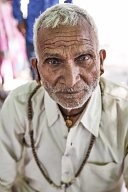
Portraits of men in Rajasthan
Sandrine Huet / Le Pictorium
LePictorium_0146629.jpg
Men of Rajasthan are very often breeders, ex nomads called Raikas.
they wear a 9 meter-long turban that is the main piece of their traditional costume. It has multi purposes and informs on the man's social status. Men in Rajasthan often have a mustache as a symbol of their virility.
they wear a 9 meter-long turban that is the main piece of their traditional costume. It has multi purposes and informs on the man's social status. Men in Rajasthan often have a mustache as a symbol of their virility.
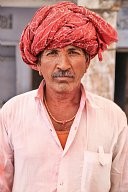
Portraits of men in Rajasthan
Sandrine Huet / Le Pictorium
LePictorium_0146630.jpg
Men of Rajasthan are very often breeders, ex nomads called Raikas.
they wear a 9 meter-long turban that is the main piece of their traditional costume. It has multi purposes and informs on the man's social status. Men in Rajasthan often have a mustache as a symbol of their virility.
they wear a 9 meter-long turban that is the main piece of their traditional costume. It has multi purposes and informs on the man's social status. Men in Rajasthan often have a mustache as a symbol of their virility.
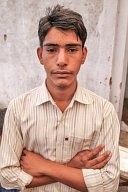
Portraits of men in Rajasthan
Sandrine Huet / Le Pictorium
LePictorium_0146635.jpg
Men of Rajasthan are very often breeders, ex nomads called Raikas.
they wear a 9 meter-long turban that is the main piece of their traditional costume. It has multi purposes and informs on the man's social status. Men in Rajasthan often have a mustache as a symbol of their virility.
they wear a 9 meter-long turban that is the main piece of their traditional costume. It has multi purposes and informs on the man's social status. Men in Rajasthan often have a mustache as a symbol of their virility.

Rajasthan
Sandrine Huet / Le Pictorium
LePictorium_0146640.jpg
Pictures of Rajasthan, portraits and lifestyles
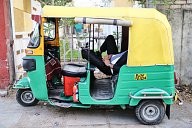
Rajasthan
Sandrine Huet / Le Pictorium
LePictorium_0146641.jpg
Pictures of Rajasthan, portraits and lifestyles
Tuk-Tuk, the Indian taxi, traditional means of transport
Tuk-Tuk, the Indian taxi, traditional means of transport
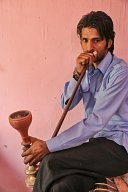
Rajasthan
Sandrine Huet / Le Pictorium
LePictorium_0146642.jpg
Pictures of Rajasthan, portraits and lifestyles
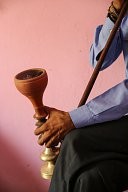
Rajasthan
Sandrine Huet / Le Pictorium
LePictorium_0146643.jpg
Pictures of Rajasthan, portraits and lifestyles
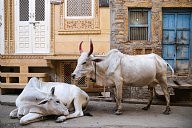
Rajasthan
Sandrine Huet / Le Pictorium
LePictorium_0146646.jpg
Pictures of Rajasthan, portraits and lifestyles
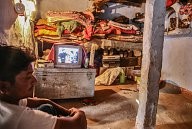
Rural lifestyle in Rajasthan
Sandrine Huet / Le Pictorium
LePictorium_0146654.jpg
interior houses in the villages of Rajasthan. Traditional lifestyle
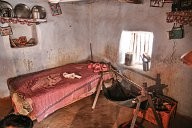
Rural lifestyle in Rajasthan
Sandrine Huet / Le Pictorium
LePictorium_0146655.jpg
interior houses in the villages of Rajasthan. Traditional lifestyle
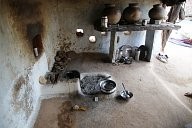
Rural lifestyle in Rajasthan
Sandrine Huet / Le Pictorium
LePictorium_0146656.jpg
interior houses in the villages of Rajasthan. Traditional lifestyle
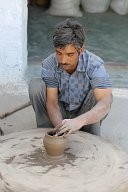
Rajasthan
Sandrine Huet / Le Pictorium
LePictorium_0146658.jpg
Pictures of Rajasthan, portraits and lifestyles
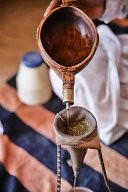
Bishnoi man preparing a decoction of opium
Sandrine Huet / Le Pictorium
LePictorium_0146659.jpg
the Bishnois are a desert tribe of Rajasthan. Bishnoi means the number 29, linked with their 29 life principles based on ecology and the respect of nature and animals.
The decoction of opium is a welcoming ritual, also used during weddings. In the past, it was also aimed to give strength and rigor to warriors and their horses.
The decoction of opium is a welcoming ritual, also used during weddings. In the past, it was also aimed to give strength and rigor to warriors and their horses.
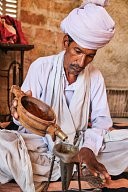
Bishnoi man preparing a decoction of opium
Sandrine Huet / Le Pictorium
LePictorium_0146660.jpg
the Bishnois are a desert tribe of Rajasthan. Bishnoi means the number 29, linked with their 29 life principles based on ecology and the respect of nature and animals.
The decoction of opium is a welcoming ritual, also used during weddings. In the past, it was also aimed to give strength and rigor to warriors and their horses.
The decoction of opium is a welcoming ritual, also used during weddings. In the past, it was also aimed to give strength and rigor to warriors and their horses.
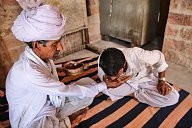
Bishnoi man preparing a decoction of opium
Sandrine Huet / Le Pictorium
LePictorium_0146661.jpg
the Bishnois are a desert tribe of Rajasthan. Bishnoi means the number 29, linked with their 29 life principles based on ecology and the respect of nature and animals.
The decoction of opium is a welcoming ritual, also used during weddings. In the past, it was also aimed to give strength and rigor to warriors and their horses.
The decoction of opium is a welcoming ritual, also used during weddings. In the past, it was also aimed to give strength and rigor to warriors and their horses.
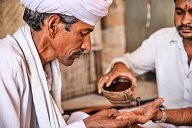
Bishnoi man preparing a decoction of opium
Sandrine Huet / Le Pictorium
LePictorium_0146662.jpg
the Bishnois are a desert tribe of Rajasthan. Bishnoi means the number 29, linked with their 29 life principles based on ecology and the respect of nature and animals.
The decoction of opium is a welcoming ritual, also used during weddings. In the past, it was also aimed to give strength and rigor to warriors and their horses.
The decoction of opium is a welcoming ritual, also used during weddings. In the past, it was also aimed to give strength and rigor to warriors and their horses.
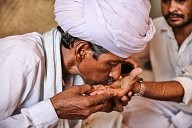
Bishnoi man preparing a decoction of opium
Sandrine Huet / Le Pictorium
LePictorium_0146663.jpg
the Bishnois are a desert tribe of Rajasthan. Bishnoi means the number 29, linked with their 29 life principles based on ecology and the respect of nature and animals.
The decoction of opium is a welcoming ritual, also used during weddings. In the past, it was also aimed to give strength and rigor to warriors and their horses.
The decoction of opium is a welcoming ritual, also used during weddings. In the past, it was also aimed to give strength and rigor to warriors and their horses.
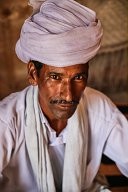
Bishnoi man preparing a decoction of opium
Sandrine Huet / Le Pictorium
LePictorium_0146664.jpg
the Bishnois are a desert tribe of Rajasthan. Bishnoi means the number 29, linked with their 29 life principles based on ecology and the respect of nature and animals.
The decoction of opium is a welcoming ritual, also used during weddings. In the past, it was also aimed to give strength and rigor to warriors and their horses.
The decoction of opium is a welcoming ritual, also used during weddings. In the past, it was also aimed to give strength and rigor to warriors and their horses.
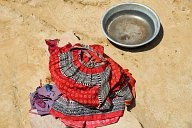
Portraits of women and children of Rajasthan. In the countryside, the women of Rajasthan wear long skirts, a small bolero and veil with bright colors. They adorn themselves with silver jewels ( earrings, nose rings, necklaces, arm and ankle bracelets). They raise the children and participate in the rural works ( cattle, farming, wood and water tasks). Most of the marriages are settled and the place of women is by and at the service of their in-laws.
Sandrine Huet / Le Pictorium
LePictorium_0146665.jpg
Pictures of Rajasthan, portraits and lifestyles

Rural lifestyle in Rajasthan
Sandrine Huet / Le Pictorium
LePictorium_0146666.jpg
interior houses in the villages of Rajasthan. Traditional lifestyle
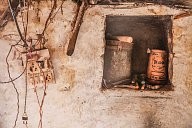
Rural lifestyle in Rajasthan
Sandrine Huet / Le Pictorium
LePictorium_0146667.jpg
interior houses in the villages of Rajasthan. Traditional lifestyle
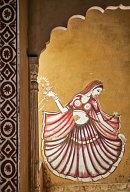
Rural lifestyle in Rajasthan
Sandrine Huet / Le Pictorium
LePictorium_0146668.jpg
interior houses in the villages of Rajasthan. Traditional lifestyle
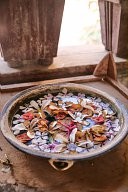
Rural lifestyle in Rajasthan
Sandrine Huet / Le Pictorium
LePictorium_0146669.jpg
interior houses in the villages of Rajasthan. Traditional lifestyle
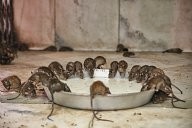
Karni Mata Temple, rat temple, Deshnok
Sandrine Huet / Le Pictorium
LePictorium_0146670.jpg
The temple at 30kms away from Bikaner is dedicated to the reincarnation of the goddess Durga, Karni Mata, the mother of miracles. Famous for the 10 000 rats living there, the temple is considered as the unique community of diurnal rats in the world. Seeing one of the rare white rats is a blessing and a manifestation of the Goddess herself. The rats are fed with milk and candies
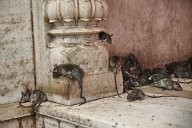
Karni Mata Temple, rat temple, Deshnok
Sandrine Huet / Le Pictorium
LePictorium_0146671.jpg
The temple at 30kms away from Bikaner is dedicated to the reincarnation of the goddess Durga, Karni Mata, the mother of miracles. Famous for the 10 000 rats living there, the temple is considered as the unique community of diurnal rats in the world. Seeing one of the rare white rats is a blessing and a manifestation of the Goddess herself. The rats are fed with milk and candies
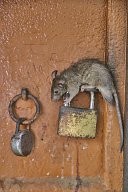
Karni Mata Temple, rat temple, Deshnok
Sandrine Huet / Le Pictorium
LePictorium_0146672.jpg
The temple at 30kms away from Bikaner is dedicated to the reincarnation of the goddess Durga, Karni Mata, the mother of miracles. Famous for the 10 000 rats living there, the temple is considered as the unique community of diurnal rats in the world. Seeing one of the rare white rats is a blessing and a manifestation of the Goddess herself. The rats are fed with milk and candies
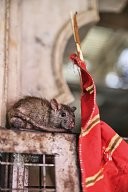
Karni Mata Temple, rat temple, Deshnok
Sandrine Huet / Le Pictorium
LePictorium_0146673.jpg
The temple at 30kms away from Bikaner is dedicated to the reincarnation of the goddess Durga, Karni Mata, the mother of miracles. Famous for the 10 000 rats living there, the temple is considered as the unique community of diurnal rats in the world. Seeing one of the rare white rats is a blessing and a manifestation of the Goddess herself. The rats are fed with milk and candies
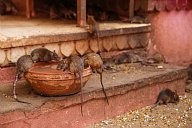
Karni Mata Temple, rat temple, Deshnok
Sandrine Huet / Le Pictorium
LePictorium_0146674.jpg
The temple at 30kms away from Bikaner is dedicated to the reincarnation of the goddess Durga, Karni Mata, the mother of miracles. Famous for the 10 000 rats living there, the temple is considered as the unique community of diurnal rats in the world. Seeing one of the rare white rats is a blessing and a manifestation of the Goddess herself. The rats are fed with milk and candies
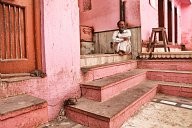
Karni Mata Temple, rat temple, Deshnok
Sandrine Huet / Le Pictorium
LePictorium_0146675.jpg
The temple at 30kms away from Bikaner is dedicated to the reincarnation of the goddess Durga, Karni Mata, the mother of miracles. Famous for the 10 000 rats living there, the temple is considered as the unique community of diurnal rats in the world. Seeing one of the rare white rats is a blessing and a manifestation of the Goddess herself. The rats are fed with milk and candies
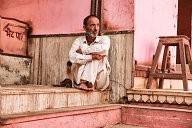
Karni Mata Temple, rat temple, Deshnok
Sandrine Huet / Le Pictorium
LePictorium_0146676.jpg
The temple at 30kms away from Bikaner is dedicated to the reincarnation of the goddess Durga, Karni Mata, the mother of miracles. Famous for the 10 000 rats living there, the temple is considered as the unique community of diurnal rats in the world. Seeing one of the rare white rats is a blessing and a manifestation of the Goddess herself. The rats are fed with milk and candies
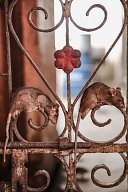
Karni Mata Temple, rat temple, Deshnok
Sandrine Huet / Le Pictorium
LePictorium_0146677.jpg
The temple at 30kms away from Bikaner is dedicated to the reincarnation of the goddess Durga, Karni Mata, the mother of miracles. Famous for the 10 000 rats living there, the temple is considered as the unique community of diurnal rats in the world. Seeing one of the rare white rats is a blessing and a manifestation of the Goddess herself. The rats are fed with milk and candies
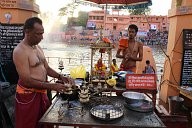
The Pujas (prayers) in India during the Khumb Mela
Sandrine Huet / Le Pictorium
LePictorium_0146029.jpg
During the Khumb Mela, millions of pilgrims attend the great pujas every night on the banks of the river Shipra. The puja is a hindu ritual of offering and adoration. The ceremony starts with a bell tinkling to call the deities and follows with the offering of fresh flowers, incense, spices and candies going with music and mantras. The puja has a predominant role during the Khumb Mela combined with the holy baths in the river, which at this time are charged with healing powers due to the magnetic radiations of the sun, the moon and Jupiter.

 Rajasthan / Sandrine Huet
Rajasthan / Sandrine Huet